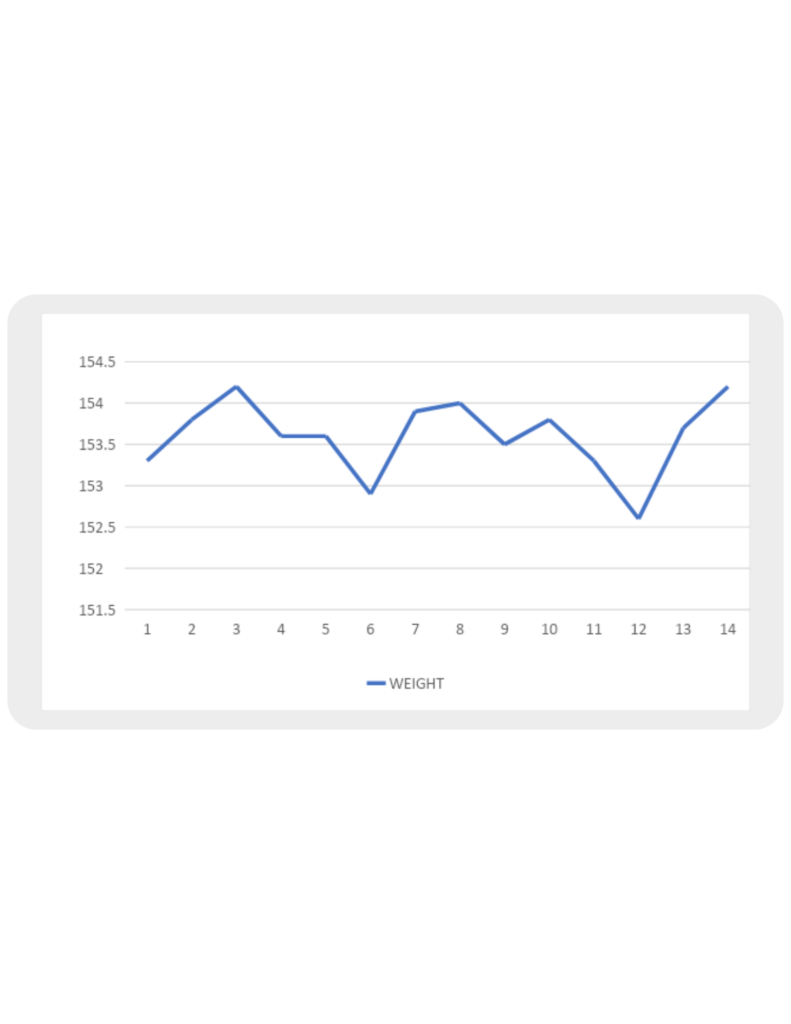
FIND A STARTING POINT
Before setting any kind of nutrition goal you need to clearly see what your habits currently are. Track at least 3-5 days including a weekend without trying to change anything. This can be tough once you’re tracking because it automatically makes you more aware of what you’re eating, but this can be helpful to see what less-than-ideal eating habits you tend to fall into.
I will use this, along with your general intake requirements using BMR calculations, past diet history, and your current goals to create your suggested initial intake. If you are not using me as a coach (why not), then below I will show you how to calculate your BMR and general intake needs that will give you a starting point. If math isn’t your jam and you don’t care how you get there, you can go straight to my MACRO CALCULATOR and it will do the math for you.
The reality of it is….it’s not magic. It’s essentially an educated guess and checks. Start with a baseline, see how your body responds, and adjust accordingly. In addition, it requires the thing that many people lack the most: CONSISTENCY. It’s a process and it takes TIME – THIS IS NOT A QUICK FIX, BUT IT LEADS TO A PERMANENT ONE.
Now for the stuff you’re here for, how do we actually go about doing this?
SETTING YOUR CALORIC INTAKE GOAL
WHAT EXACTLY IS A CALORIE?
CALORIE: A unit of energy that is required to increase the temperature of 1 kilogram of water by 1 degree Celsius. We use it to measure the energy value of food.
So how do we find out how many calories you need? There are a few ways.
First, let’s go over some vocabulary.
BASAL METABOLIC RATE: the total number of calories needed to function at the minimum level. BMR supports breathing, circulating blood, organ functions, and basic neurological functions. It is proportional to lean body mass and decreases by approximately 0.01 kcal/min for each 1% increase in body fat.
TOTAL DAILY ENERGY EXPENDITURE (TDEE) or Maintenance calories is the amount of energy it takes for you to live your best life – including all activities (workouts & day-to-day activities).
There are many ways to do this – some more accurate than others. I’m going to give you 3 ways to calculate BMR. They are listed from the least accurate, but most simple, to the most accurate and most complicated.
I’ll be transparent, the software I use gives me these basic calculations based on the information you input for your profile and I adjust as needed based on additional information (current intake, past diet history, preference). However, as I said before – these are GENERAL suggestions and have been found to be up to a 26% variance in metabolic rates between people with similar statistics. This is where things like your past diet history, lifestyle, and activity levels come into play. These initial calculations are also a good tool to see where you’re at in regard to the healthy averages. With a variance in mind, if you have been chronically dieting, due to metabolic adaptation your maintenance may be well below optimal. This can be a sign you may want to work toward a reverse diet or a building season. [See reverse dieting pg 35]
OPTION 1: GOAL MULTIPLIER
GOAL BODYWEIGHT MULTIPLIED BY GOAL VALUE BELOW = CALS
Fat loss 12-13
Maintenance 15-16
Weight Gain (Muscle Building) 18-19
OPTION 2: ACTIVITY MULTIPLIER
Basal Metabolic Rate is the amount of energy your body expends on a daily basis JUST TO KEEP YOU ALIVE. This does NOT INCLUDE exercise, which is why there is an activity multiplier. This one is far more accurate than the above but does require a little more math. This is the equation used on my MACRO CALCULATOR.
There are 3 different main equations that can be used – some use a body fat percentage which is more accurate, but this one is more simple and is now considered to be the most accurate of its kind.
BMR: Mifflin-St Jeor Equation:
For men: BMR = 10W(kg) + 6.25H(cm) – 5A + 5
For women: BMR = 10W(kg) + 6.25H(cm) – 5A – 161
Where, W = weight (kg); H = height (cm); and A = age
ACTIVITY MULTIPLIER
EXAMPLE:
I’m 5’8”, I weigh 145lbs and I’m 29 years old.
First, you have to convert your weight into kg and your height into cm. Conversions are as follows:
Height: 5’8”= 68in *2.54cm = 172.72cm
Weight: 145lbs/ 2.2kg = 65kg
My equation would look like this:
10*65kg + 6.25*172cm – 5*29 -161 = BMR
650 + 1075 – 145 – 161= 1419
I lift/play sports/run 6-7 days/week so, I’m going to use the 1.55 multiplier.
1419*1.55 = 2199KCALS/DAY
THIS IS THE AMOUNT OF CALORIES REQUIRED FOR ME TO MAINTAIN MY WEIGHT.
I can tell you from experience that this is about right. Depending on how hard my workouts are and if I’m playing soccer, it may be slightly higher than this. When I was lifting 6 days/week hard and heavy I was eating about 2400 cals/day and actually still losing weight.
If this is too much math for you, or you want to check your numbers…
USE MY MACRO CALCULATOR
OPTION 3: TRACK YOUR FOOD & TRACK YOUR WEIGHT
This is the most accurate and least convenient way to find your maintenance, but what I recommend everyone do even if you’ve done the above calculations. The calculations gave you a starting point, but due to individual variance, you can calculate till your head explodes and still not find YOUR maintenance. The only TRUE way to find it is to track your food as diligently and accurately as possible while being CONSISTENT WITH YOUR INTAKE (within 100-150 cals) and then recording what your body is doing.
Begin with one of the above calculations, then monitor your results. Ideally, you need at least two weeks of this and while you don’t have to weigh EVERY day, the more you weigh yourself (especially if you’re only going to do it for 2 weeks) the more accurate picture you will have. Keep in mind, the scale fluctuations on a daily basis MEAN VERY LITTLE. You’re looking for this general trend over the two-week tracking period. So here’s what finding your maintenance might look like.


Caloric Averages
I don’t ever expect someone to eat the exact same number of calories every single day for the rest of their life. The whole point of flexible dieting is to have some variance. Just like the weight, you’re looking for the AVERAGE TOTALS to be similar from week to week.
Your days can vary as long as your weekly average is fairly consistent. The way we would find your daily caloric total from the above example of 2 weeks of tracking would look like this:
13296 cals/week divided by 7 days = 1899 calories/day
13147 cals/week divided by 7 days = 1878 calories/day
Average the 2 days: 1899 calories/day + 1878 calories/day / 2 = 1888 cals/day

This is very thorough and I don’t expect you to track your food every day forever, that’s not the point. However, without the baseline education that tracking your food gives you it will be difficult, if not impossible, to find a balance between eating what your body really needs vs what’s available, what you crave, and what you’re in the habit of eating.
Currently, I can look at a plate of food and guess usually within 1-200 calories and 10g of macros what the totals are because I tracked religiously for 3 years while competing. While this is a blessing and a curse, I would rather KNOW what impact my choices are having vs flying blind. I can still make the decision to eat the whole pint of ice cream, but at least it’s an informed decision.
If you have calculated your calories with one of the above equations, you’re diligently tracking and logging your weight, and you’re seeing a general trend of INCREASING or DECREASING weight over those two weeks – YOU’RE NOT AT MAINTENANCE.
Read on to see how to make adjustments.

Women’s Functional Nutritionist & Fitness Specialist along with CEO of Elysian Women’s Wellness.
God, family, fitness – in that order. Fitness isn’t my job, it’s my passion. My favorite things include traveling the world, being a mama and making a difference.
14 years of experience in the wellness industry has brought me to an understanding that when you’re ready – you’ll do it. So when you are, we’re here to keep you simply well.
The last “program” you’ll ever buy. Your individualized training & nutrition plan that teaches the why & how to create lasting changes with me by your side every step of the way!

Error: No feed found.
Please go to the Instagram Feed settings page to create a feed.
Level 0, 1, 2 & 3: Level Up your workouts with beginner to advanced plans designed with a focus lift each month, progressive overload, instructional videos & all inclusive training & nutrition guides.
Copyright ©2025. Gamechanger
A BRANDT CREATIVE CO. TEMPLATE. Trusted by Wimgo.